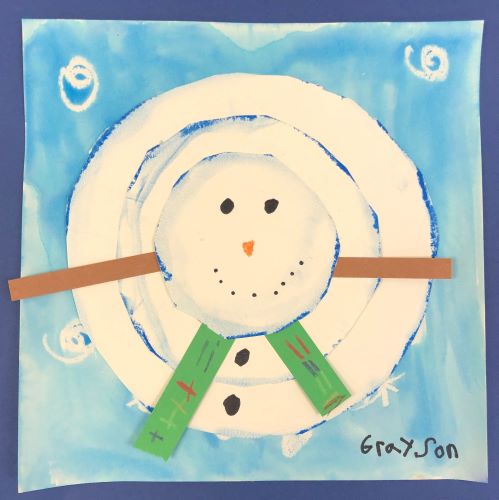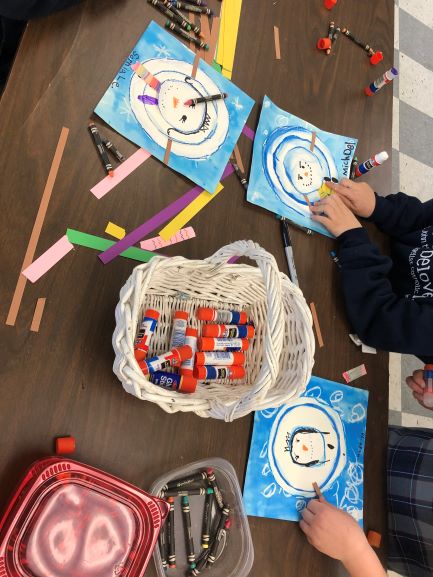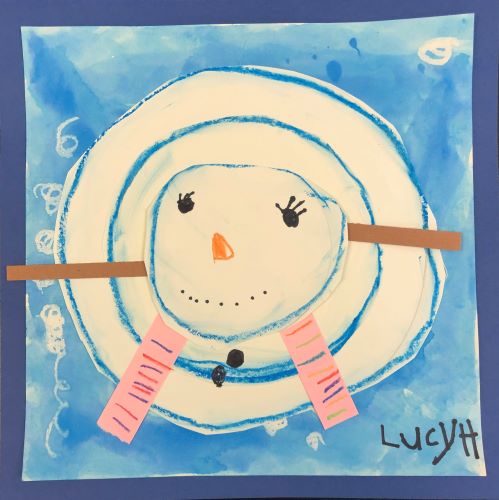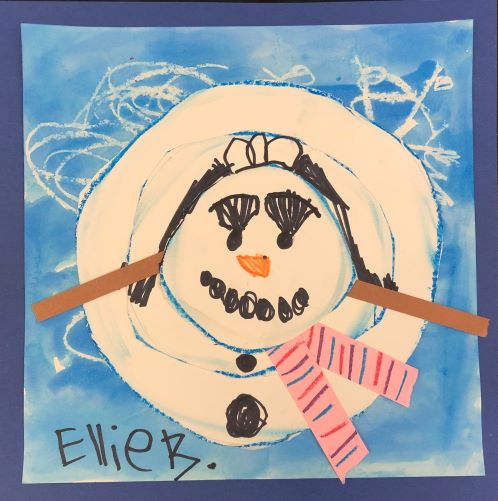
Even from a “Snowman Perspective” this is adorable. Elementary aged students will melt the hearts of everyone when they add the smile on their snowperson. This project covers Common Core Standards for Science and Math for grades K-1 which can be found at the end of the lesson.
Grade Level
Kindergarten, 1st, and 2nd. This project was created by Kindergarten students.
Objective for Snowman Perspective Art
Elementary aged students will create a layered snowman while learning about perspective.
Time
4 – 30 min lessons totally depends on type and size of class and if you have help
Materials
- Oil pastels (Blue, White, ) – Pentel Arts Oil Pastels, 50 Color Set (PHN-50)
- Black Sharpie Marker – Sharpie Permanent Marker, Fine Point, Black, Pack of 5
- 9×12 Watercolor paper – Canson (100510941) XL Series Watercolor Pad, 9″ x 12″, Fold-Over Cover, 30 Sheets
- Brushes – Acrylic Paint Brush Set, 1 Packs / 10 pcs Nylon Hair Brushes for All Purpose Oil Watercolor Painting Artist Professional Kits
- Liquid Water Colors – Sargent Art 22-6010 10-Count 8-Ounce Watercolor Magic Set
- Or this mini version for homeschooling – Sargent Art 22-6210 10-Count 4-Ounce Watercolor Magic
- Kleenex for blotting paint
- 9×12 Royal Blue paper – Tru-Ray Heavyweight Construction Paper, Royal Blue, 9″ x 12″, 50 Sheets
- Brown paper – SunWorks Heavyweight Construction Paper, 9 x 12 Inches, Brown, 100 Sheets
- Variety of colors for scarf – Tru-Ray Construction Paper, 10 Classic Colors, 9″ x 12″, 50 Sheets
- Glue sticks
- Scissors
Inspiration/Artist
I made this project from this awesome site, Tinyartroom: Click Here
Instruction with Questions
First
At the younger levels, I still use the word perspective. I use it over and over again with lots of examples. It is also important to call it different things

I will sometimes have a student come to the front of the room and I will ask for their perspective. Then I lie on the ground and ask them how they think my perspective has changed. Next, I stand on the desk and look down at the top of their head. The main goal here is to have them think about how we view things using different points of view.
Next
Below, are some great examples I show them of a very famous snowman, Olaf. I ask the students to at him from some different perspectives. Where is the person holding the camera when looking at Olaf? How close is the person? Are they above or below? Etc. The goal here is that we know that a snowman is sometimes three layers and we often draw them 2D facing forward. But animators need to think of different perspectives to make the character come alive. So, they need to think of how to draw those things from different angles and points of view.














Second
Show students a variety of ways to draw snowflakes. Circles, spirals, crossing xs etc. Then, using white oil pastels, students cover a pre-cut 8×8 piece of watercolor paper with snowflakes.

Third
Using watered down liquid blue watercolor, students paint over their snowflakes.

Fourth
The outside blue construction paper will be 9×9 because the main size is 9×12.
The watercolor paper is 8×8. To make the circles, trace ones that are approximately 7″, 6″ and 5″ in diameter. You will trace them in pencil. Then, students will trace over them using blue oil pastels. Have them smudge them so it adds a snow-like quality to them. As you can see, I number mine based on their alphabetical order number on my roster. That way I don’t need to write their name. This also helps with making sure you have them all. I had a huge class and no aide, so I did this in mini-steps.

Fifth
Number the back of each circle so they can find their own once they are cut out. Then paperclip them together.


Sixth
Students glue their circles on, large, medium and small. I show an example of how to add a face and scarf. The scarf can have a pattern or any design they choose. I show them how to add glue to one end and stick it under the circle to hide it underneath. The stick arms go under the medium or small circle. The scarf pieces go under the small circle. I love all of the personality they add to their snow people.
Finally, back with the blue construction paper for an added pop.

Check out these finished Snowman Perspective art pieces!
Common Core Standards for Snowman Perspective Art
Kindergarten – Math
Measurement and Data
Describe and compare measurable attributes.
- Describe measurable attributes of objects, such as length or weight. And describe several measurable attributes of a single object.
- Directly compare two objects with a measurable attribute in common, to see which object has “more of”/“less of” the attribute, and describe the difference. For example, directly compare the heights of two children and describe one child as taller/shorter.
Geometry
Identify and describe shapes (squares, circles, triangles, rectangles, hexagons, cubes, cones, cylinders, and spheres).
- Describe objects in the environment using names of shapes, and describe the relative positions of these objects using
terms such as above, below, beside, in front of, behind, and next to. - Correctly name shapes regardless of their orientations or overall size.
- Identify shapes as two-dimensional (lying in a plane, “flat”) or three-dimensional (“solid”).
Analyze, compare, create, and compose shapes.
- Analyze and compare two- and three-dimensional shapes, in different sizes and orientations, using informal language to describe their similarities, differences, parts (e.g., number of sides and vertices/“corners”) and other attributes (e.g., having sides of equal length).
- Model shapes in the world by building shapes from components (e.g., sticks and clay balls) and drawing shapes.
Kindergarten – Science
Investigation and Experimentation
4. Scientific progress is made by asking meaningful questions and conducting careful investigations.
a. Observe common objects by using the five senses.
b. Describe the properties of common objects.
c. Describe the relative position of objects by using one reference (e.g., above or below).
d. Compare and sort common objects by one physical attribute (e.g., color, shape, texture, size, weight).
e. Communicate observations orally and through drawings.
Grade 1 – Science
Investigation and Experimentation
4. Scientific progress is made by asking meaningful questions and conducting careful investigations.
a. Draw pictures that portray some features of the thing being described.
b. Record observations and data with pictures, numbers, or written statements.
c. Record observations on a bar graph.
d. Describe the relative position of objects by using two references (e.g., above and next to, below and left of).
e. Make new observations when discrepancies exist between two descriptions of the same object or phenomenon.














Leave a Reply